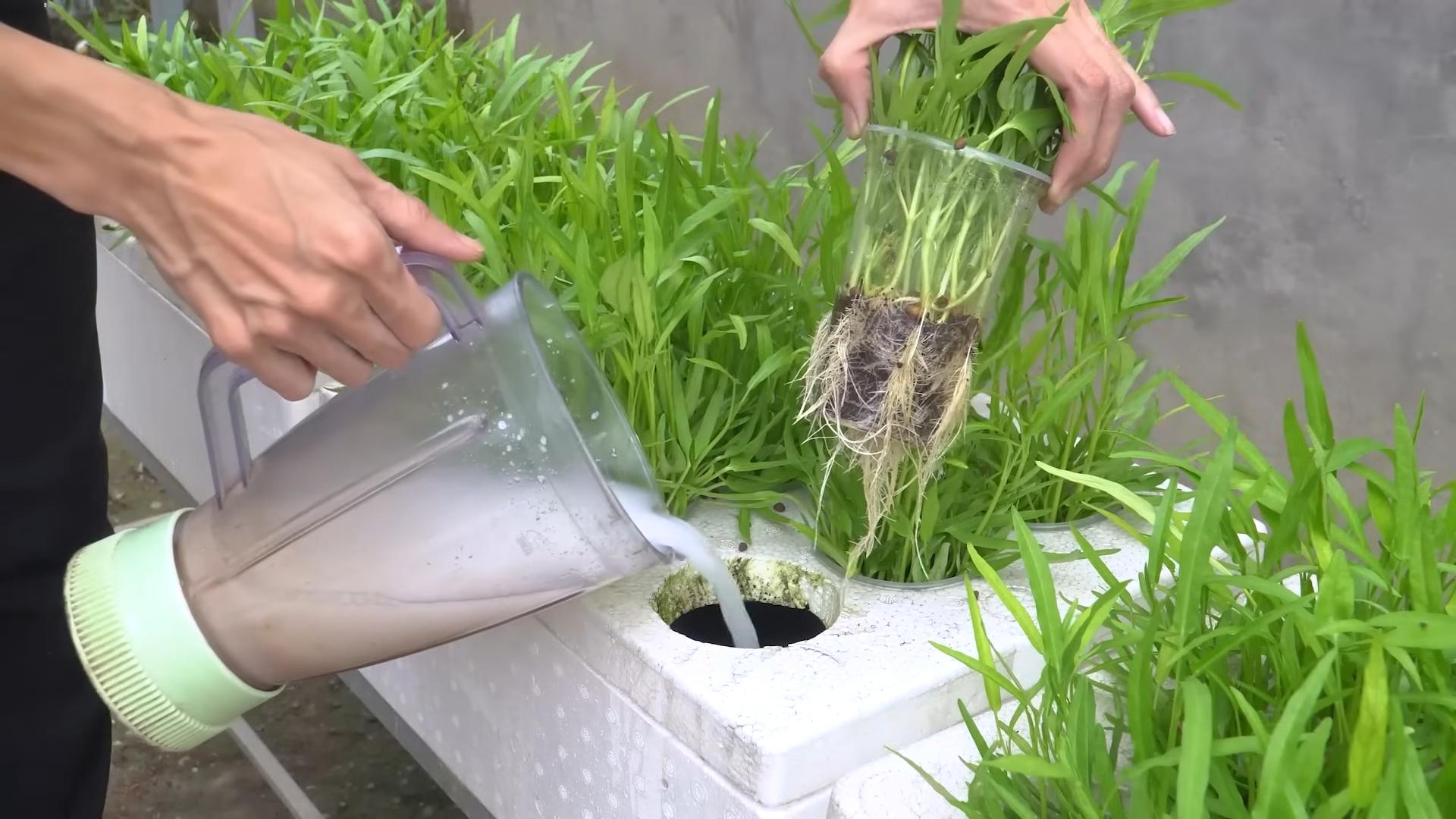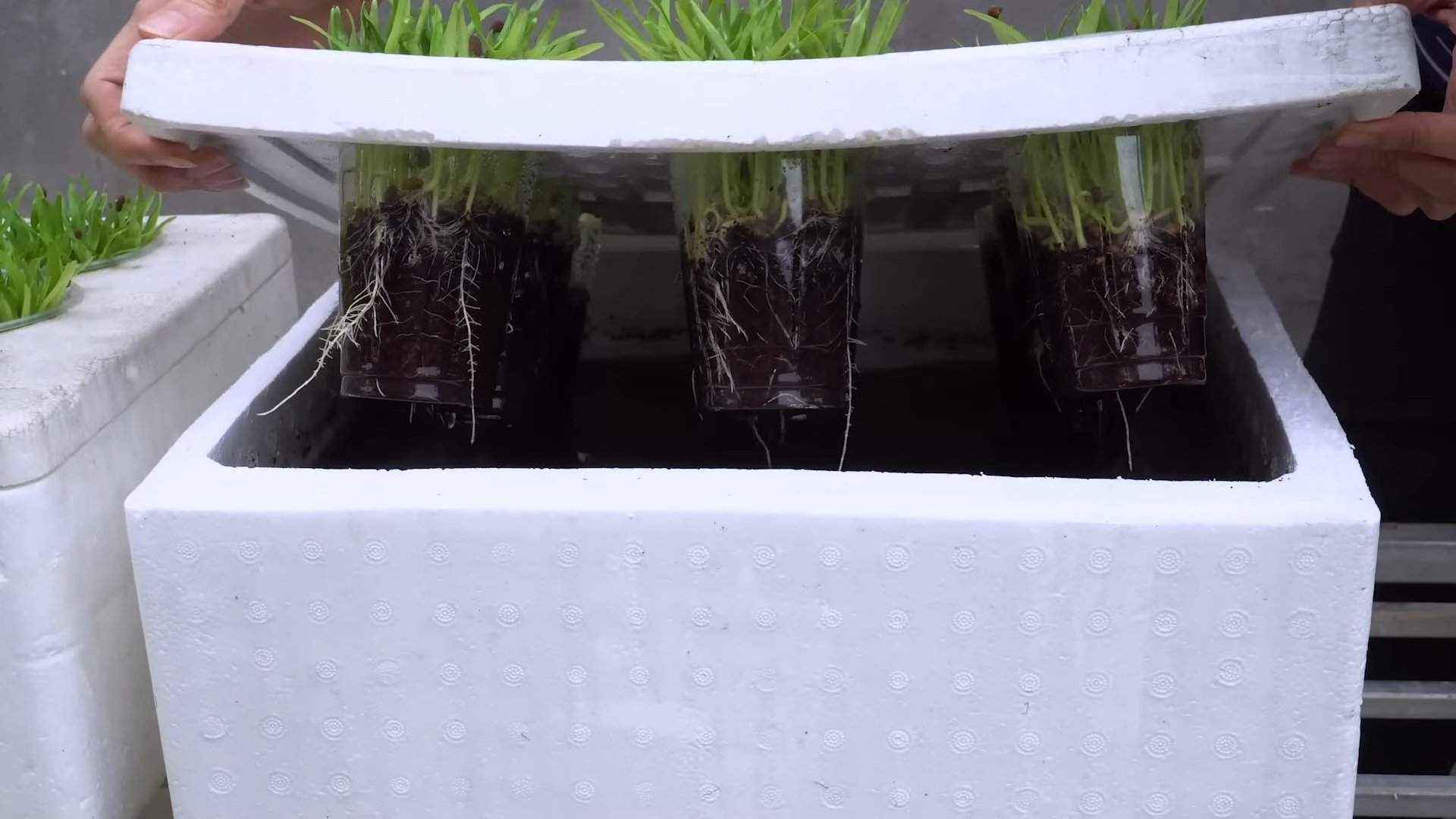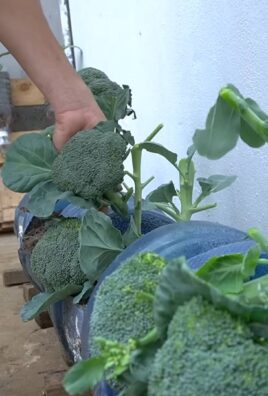Grow water spinach quickly? Absolutely! Imagine harvesting fresh, vibrant water spinach from your own backyard in just a few weeks. Sounds like a dream, right? Well, it doesn’t have to be! This DIY guide is packed with simple yet effective tricks to accelerate the growth of this delicious and nutritious leafy green.
Water spinach, also known as Ong Choy or Kang Kong, has been a staple in Asian cuisine for centuries. From stir-fries to soups, its versatility and mild flavor make it a beloved ingredient. But beyond its culinary appeal, growing your own water spinach offers a sense of accomplishment and a connection to nature. Plus, you’ll have a constant supply of fresh, organic greens right at your fingertips!
In today’s fast-paced world, we often rely on grocery stores for our produce. But what if you could bypass the long lines and questionable freshness? That’s where this DIY guide comes in. I’m going to share my secrets to help you grow water spinach quickly and efficiently, even if you have limited space or gardening experience. We’ll cover everything from seed selection to optimal growing conditions, ensuring a bountiful harvest in no time. So, grab your gardening gloves and let’s get started on this exciting journey to fresh, homegrown water spinach!

Grow Water Spinach Like a Pro: A DIY Guide to Rapid Growth
Hey there, fellow gardening enthusiasts! I’m so excited to share my tried-and-true method for growing water spinach, also known as kangkong or ong choy, at lightning speed. This leafy green is a staple in Asian cuisine, and trust me, once you taste freshly grown water spinach, you’ll be hooked! The best part? It’s incredibly easy to grow yourself, even if you don’t have a lot of space. Let’s dive in!
What You’ll Need
Before we get started, let’s gather all the necessary supplies. This will make the whole process smoother and more enjoyable.
* Water Spinach Seeds: You can find these online or at most Asian grocery stores. Look for varieties that are known for their fast growth.
* A Container: A large bucket, tub, or even a repurposed storage container will work perfectly. Aim for something at least 12 inches deep.
* Potting Mix: A good quality potting mix is essential for healthy growth. I prefer a mix that’s rich in organic matter.
* Water: Obviously! Use tap water that’s been sitting out for a day or two to allow chlorine to dissipate.
* Fertilizer: A balanced liquid fertilizer will give your water spinach a boost. I like using a 20-20-20 formula diluted to half strength.
* Sunlight: Water spinach loves sunshine! Choose a spot that gets at least 6 hours of direct sunlight per day.
* Optional: A small aquarium pump and air stone can help oxygenate the water, promoting even faster growth.
Getting Started: Seed Germination
The first step is to germinate your water spinach seeds. This will give them a head start and ensure a higher success rate.
1. Soak the Seeds: Place the water spinach seeds in a bowl of warm water and let them soak for 12-24 hours. This will soften the seed coat and encourage germination. I usually do this overnight.
2. Prepare a Seed Tray: Fill a seed tray or small containers with moist potting mix. Make sure the mix is damp but not soggy.
3. Sow the Seeds: Sow the seeds about half an inch deep in the potting mix. Space them about an inch apart.
4. Cover and Water: Gently cover the seeds with a thin layer of potting mix and water them thoroughly. Use a spray bottle to avoid disturbing the seeds.
5. Create a Humid Environment: Cover the seed tray with a plastic lid or plastic wrap to create a humid environment. This will help the seeds germinate faster.
6. Place in a Warm Location: Place the seed tray in a warm location, such as a sunny windowsill or a greenhouse. The ideal temperature for germination is between 70-85°F (21-29°C).
7. Monitor and Water: Keep the potting mix moist but not soggy. Check the seed tray daily and water as needed. You should see sprouts within 3-7 days.
Setting Up Your Water Spinach Container
Now that your seeds are germinating, let’s prepare the container where your water spinach will grow.
1. Choose Your Container: Select a container that’s large enough to accommodate the mature plants. A 5-gallon bucket or a similar-sized container is a good starting point.
2. Drill Drainage Holes (Optional): If you’re using a container that doesn’t have drainage holes, drill a few holes in the bottom. This will prevent the soil from becoming waterlogged. However, for a semi-aquatic setup, you can skip this step and maintain a water level.
3. Add Potting Mix: Fill the container with potting mix, leaving about 2-3 inches of space at the top.
4. Water the Potting Mix: Water the potting mix thoroughly until it’s evenly moist.
Transplanting Your Seedlings
Once your seedlings have developed a few true leaves, it’s time to transplant them into the container.
1. Gently Remove Seedlings: Carefully remove the seedlings from the seed tray, being careful not to damage the roots. I like to use a small spoon or fork to help lift them out.
2. Prepare Planting Holes: Make small holes in the potting mix in your container, spacing them about 4-6 inches apart.
3. Transplant Seedlings: Place the seedlings into the holes and gently cover the roots with potting mix.
4. Water Thoroughly: Water the transplanted seedlings thoroughly to help them settle in.
Watering and Fertilizing
Water spinach loves water, so it’s important to keep the soil consistently moist.
1. Water Regularly: Water your water spinach daily, especially during hot weather. The soil should always be moist to the touch.
2. Consider a Semi-Aquatic Setup: For even faster growth, you can create a semi-aquatic environment by adding water to the container until it’s about 2-3 inches deep. The water spinach will readily grow in the water.
3. Fertilize Regularly: Fertilize your water spinach every 2-3 weeks with a balanced liquid fertilizer diluted to half strength. This will provide the nutrients it needs to grow quickly. I find that a fertilizer high in nitrogen really helps with leafy growth.
Sunlight and Temperature
Water spinach thrives in warm, sunny conditions.
1. Provide Plenty of Sunlight: Place your water spinach container in a location that receives at least 6 hours of direct sunlight per day.
2. Maintain Warm Temperatures: Water spinach grows best in temperatures between 70-85°F (21-29°C). If you live in a cooler climate, you may need to provide supplemental heat.
Harvesting Your Water Spinach
The best part! You can start harvesting your water spinach as soon as it reaches about 6-8 inches in height.
1. Harvest Regularly: Harvest the stems and leaves by cutting them off about 2 inches above the soil line. This will encourage the plant to produce new growth.
2. Harvest in the Morning: Harvest your water spinach in the morning, when the leaves are at their freshest.
3. Enjoy Your Harvest: Water spinach is delicious stir-fried, steamed, or added to soups and salads.
Tips for Rapid Growth
Here are a few extra tips to help you grow water spinach even faster:
* Use an Aquarium Pump: Adding a small aquarium pump and air stone to the water will help oxygenate the water and promote faster growth.
* Provide Support: As the water spinach grows, it may need some support. You can use stakes or a trellis to help keep the stems upright.
* Pinch Off Flowers: Pinch off any flowers that appear to encourage the plant to focus its energy on producing leaves.
* Maintain Water Quality: If you’re growing your water spinach in a semi-aquatic environment, change the water every week or two to prevent algae growth and maintain water quality.
* Consider Hydroponics: For the absolute fastest growth, consider growing your water spinach hydroponically. There are many DIY hydroponic systems you can build at home.
Troubleshooting
Even with the best care, you may encounter some problems while growing water spinach. Here are a few common issues and how to address them:
* Yellowing Leaves: Yellowing leaves can be a sign of nutrient deficiency. Try fertilizing your water spinach with a balanced liquid fertilizer.
* Slow Growth: Slow growth can be caused by a lack of sunlight, water, or nutrients. Make sure your water spinach is getting enough of all three.
* Pests: Water spinach is generally pest-resistant, but it can occasionally be attacked by aphids or spider mites. Treat infestations with insecticidal soap or neem oil.
* Algae Growth: Algae growth in the water can be a problem in semi-aquatic setups. Change the water regularly and consider adding a small amount of hydrogen peroxide to the water to kill algae.
Enjoying Your Homegrown Water Spinach
Growing your own water spinach is a rewarding experience. Not only will you have a fresh, delicious vegetable to enjoy, but you’ll also have the satisfaction of knowing that you grew it yourself. So, get started today and enjoy the taste of homegrown goodness! I hope this guide helps you achieve a bountiful harvest. Happy gardening!

Conclusion
So, there you have it! Growing water spinach quickly at home is not only achievable but also incredibly rewarding. Forget those expensive grocery store prices and often wilted bunches. With this simple DIY trick, you can have a constant supply of fresh, crisp, and vibrant water spinach right at your fingertips.
This method is a must-try for several reasons. First, it’s incredibly cost-effective. You’re essentially recycling materials and using readily available resources, saving you money in the long run. Second, it’s fast! You’ll be amazed at how quickly your water spinach sprouts and grows, providing you with a harvest much sooner than traditional gardening methods. Third, it’s convenient. You can easily set up this system indoors or outdoors, making it perfect for anyone, regardless of their living situation or gardening experience. Finally, and perhaps most importantly, you know exactly what you’re eating. No pesticides, no hidden chemicals, just pure, homegrown goodness.
But the fun doesn’t stop there! Feel free to experiment with different variations to personalize your water spinach growing experience. Try using different types of containers, such as repurposed plastic tubs or even old buckets. You can also experiment with different nutrient solutions to see which one yields the best results for you. Some gardeners swear by adding a small amount of fish emulsion to the water, while others prefer using a balanced hydroponic fertilizer.
Consider the lighting too. While water spinach thrives in sunlight, you can supplement with grow lights if you’re growing indoors or during periods of low light. This can help to boost growth and ensure a consistent harvest. You can also try growing different varieties of water spinach. Some varieties are more heat-tolerant than others, while some have a slightly different flavor profile.
Don’t be afraid to get creative and adapt this method to suit your specific needs and preferences. The beauty of DIY is that it’s all about experimentation and finding what works best for you.
We are confident that once you try this method for growing water spinach quickly, you’ll be hooked. It’s a simple, effective, and satisfying way to enjoy fresh, healthy greens all year round. So, gather your supplies, follow the steps outlined, and get ready to witness the magic of homegrown water spinach.
We’re eager to hear about your experiences! Share your photos, tips, and tricks in the comments below. Let us know what worked well for you, what challenges you faced, and any variations you tried. Your feedback will not only help other readers but also contribute to a growing community of water spinach enthusiasts. Together, we can all learn and grow (literally!) from each other’s experiences. Happy growing!
Frequently Asked Questions (FAQ)
What exactly is water spinach, and why should I grow it?
Water spinach, also known as Ong Choy or Kang Kong, is a leafy green vegetable popular in Asian cuisine. It’s known for its mild, slightly sweet flavor and its crisp, hollow stems. It’s incredibly versatile and can be stir-fried, steamed, boiled, or even eaten raw in salads. Growing it yourself ensures you have a fresh, readily available supply, often at a fraction of the cost of buying it from the store. Plus, you control the growing environment, ensuring it’s free from harmful pesticides and chemicals.
How long does it actually take to grow water spinach quickly using this method?
While the exact timeframe can vary depending on factors like temperature, sunlight, and nutrient solution, you can generally expect to see sprouts within a few days. Within 2-3 weeks, you should have a harvestable crop. This is significantly faster than traditional soil-based gardening, where it can take several weeks or even months to reach maturity. The key is to provide consistent moisture, adequate sunlight, and a nutrient-rich environment.
What kind of container is best for growing water spinach using this DIY trick?
Almost any container that can hold water will work! Repurposed plastic tubs, buckets, large bowls, or even old storage containers are all excellent options. The most important thing is to ensure the container is clean and food-safe. Also, consider the size of the container. A larger container will allow you to grow more water spinach at once. Make sure the container is opaque or dark-colored to prevent algae growth.
What kind of nutrient solution should I use?
You have several options for nutrient solutions. A simple solution is to use a diluted hydroponic fertilizer specifically formulated for leafy greens. Follow the instructions on the fertilizer packaging carefully to avoid over-fertilizing. Alternatively, you can use a diluted fish emulsion or compost tea. These are more natural options but may require more frequent applications. Experiment to see what works best for your growing environment.
How much sunlight does water spinach need?
Water spinach thrives in full sun, meaning at least 6-8 hours of direct sunlight per day. If you’re growing indoors, you’ll likely need to supplement with grow lights. LED grow lights are a great option as they are energy-efficient and provide the necessary spectrum of light for plant growth. Position the grow lights a few inches above the plants and adjust as they grow.
How often should I change the water and nutrient solution?
It’s generally recommended to change the water and nutrient solution every 1-2 weeks. This helps to prevent the buildup of algae and bacteria and ensures that the water spinach has access to fresh nutrients. When changing the water, be sure to gently rinse the roots to remove any debris.
Can I grow water spinach from cuttings?
Yes, you can! This is a great way to propagate new plants from existing ones. Simply take a cutting from a mature water spinach plant, making sure it has at least a few nodes (the points where leaves emerge). Place the cutting in water, and roots should start to develop within a few days. Once the roots are a few inches long, you can transplant the cutting into your DIY growing system.
Is it possible to grow water spinach indoors year-round?
Absolutely! With the right conditions, you can enjoy fresh water spinach all year round, regardless of the weather outside. The key is to provide adequate light, warmth, and humidity. Use grow lights to supplement natural sunlight, maintain a consistent temperature of around 70-80°F (21-27°C), and mist the plants regularly to increase humidity.
What are some common problems I might encounter when growing water spinach, and how can I fix them?
Some common problems include yellowing leaves, slow growth, and algae growth. Yellowing leaves can indicate a nutrient deficiency, so try increasing the concentration of your nutrient solution. Slow growth can be caused by insufficient light or temperature, so adjust accordingly. Algae growth can be prevented by using an opaque container and changing the water regularly.
How do I harvest water spinach?
You can harvest water spinach by cutting the stems a few inches above the water line. This will encourage the plant to produce new shoots, allowing you to harvest multiple times. Alternatively, you can harvest individual leaves as needed. Be sure to harvest regularly to prevent the plant from becoming too leggy.
Is water spinach healthy?
Yes! Water spinach is packed with vitamins and minerals, including vitamin A, vitamin C, iron, and calcium. It’s also a good source of fiber and antioxidants. Adding water spinach to your diet can help boost your immune system, improve digestion, and protect against chronic diseases.
Can I eat the entire water spinach plant?
Yes, you can eat the entire plant, including the leaves and stems. The stems are slightly tougher than the leaves, so you may want to cook them for a longer time.
What are some delicious ways to use my homegrown water spinach?
The possibilities are endless! Water spinach is delicious stir-fried with garlic and chili, added to soups and stews, or used in salads. It’s also a popular ingredient in Asian dishes like Pad See Ew and morning glory salad. Get creative and experiment with different recipes to find your favorite way to enjoy this versatile vegetable.




Leave a Comment